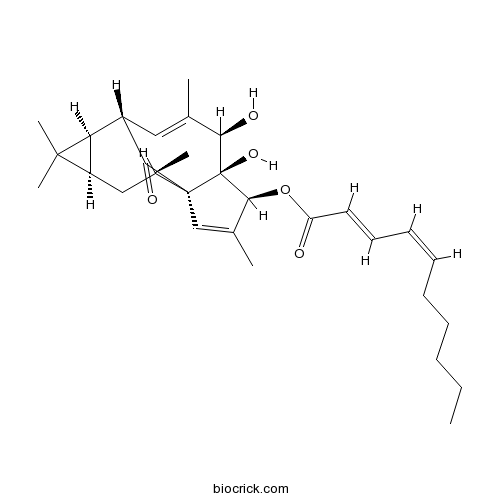3-O-(2'E ,4'Z-decadienoyl)-20-deoxyingenolCAS# 672941-64-9 |

Quality Control & MSDS
3D structure
Package In Stock
Number of papers citing our products

| Cas No. | 672941-64-9 | SDF | Download SDF |
| PubChem ID | 101254244 | Appearance | Powder |
| Formula | C30H42O5 | M.Wt | 482.7 |
| Type of Compound | Diterpenoids | Storage | Desiccate at -20°C |
| Solubility | Soluble in Chloroform,Dichloromethane,Ethyl Acetate,DMSO,Acetone,etc. | ||
| SMILES | CCCCCC=CC=CC(=O)OC1C(=CC23C1(C(C(=CC(C2=O)C4C(C4(C)C)CC3C)C)O)O)C | ||
| Standard InChIKey | JZIBSDBSLIKLEM-SPXYNGGESA-N | ||
| General tips | For obtaining a higher solubility , please warm the tube at 37 ℃ and shake it in the ultrasonic bath for a while.Stock solution can be stored below -20℃ for several months. We recommend that you prepare and use the solution on the same day. However, if the test schedule requires, the stock solutions can be prepared in advance, and the stock solution must be sealed and stored below -20℃. In general, the stock solution can be kept for several months. Before use, we recommend that you leave the vial at room temperature for at least an hour before opening it. |
||
| About Packaging | 1. The packaging of the product may be reversed during transportation, cause the high purity compounds to adhere to the neck or cap of the vial.Take the vail out of its packaging and shake gently until the compounds fall to the bottom of the vial. 2. For liquid products, please centrifuge at 500xg to gather the liquid to the bottom of the vial. 3. Try to avoid loss or contamination during the experiment. |
||
| Shipping Condition | Packaging according to customer requirements(5mg, 10mg, 20mg and more). Ship via FedEx, DHL, UPS, EMS or other couriers with RT, or blue ice upon request. | ||
| Description | 1. 3-O-(2'E ,4'Z-decadienoyl)-20-deoxyingenol, one toxic terpenoid from raw Gansui. 2. 3-O-(2′E,4′Z-decadienoyl)-20-O-acetylingenol has strong cytotoxicity against human normal cell lines L-O2 and GES-1 with dose-dependent relationships. 3. 3-O-(2′E,4′Z-decadienoyl)-20-O-acetyl-ingenol and 3-O-(2′E,4′E-decadienoyl)-ingenol show cytotoxicity on Namalwa cells with IC 50 values of 7.6 and 5.2 umol·L-1, respectively. |

3-O-(2'E ,4'Z-decadienoyl)-20-deoxyingenol Dilution Calculator

3-O-(2'E ,4'Z-decadienoyl)-20-deoxyingenol Molarity Calculator
| 1 mg | 5 mg | 10 mg | 20 mg | 25 mg | |
| 1 mM | 2.0717 mL | 10.3584 mL | 20.7168 mL | 41.4336 mL | 51.792 mL |
| 5 mM | 0.4143 mL | 2.0717 mL | 4.1434 mL | 8.2867 mL | 10.3584 mL |
| 10 mM | 0.2072 mL | 1.0358 mL | 2.0717 mL | 4.1434 mL | 5.1792 mL |
| 50 mM | 0.0414 mL | 0.2072 mL | 0.4143 mL | 0.8287 mL | 1.0358 mL |
| 100 mM | 0.0207 mL | 0.1036 mL | 0.2072 mL | 0.4143 mL | 0.5179 mL |
| * Note: If you are in the process of experiment, it's necessary to make the dilution ratios of the samples. The dilution data above is only for reference. Normally, it's can get a better solubility within lower of Concentrations. | |||||

Calcutta University

University of Minnesota

University of Maryland School of Medicine

University of Illinois at Chicago

The Ohio State University

University of Zurich

Harvard University

Colorado State University

Auburn University

Yale University

Worcester Polytechnic Institute

Washington State University

Stanford University

University of Leipzig

Universidade da Beira Interior

The Institute of Cancer Research

Heidelberg University

University of Amsterdam

University of Auckland

TsingHua University

The University of Michigan

Miami University

DRURY University

Jilin University

Fudan University

Wuhan University

Sun Yat-sen University

Universite de Paris

Deemed University

Auckland University

The University of Tokyo

Korea University
- Kif15-IN-2
Catalog No.:BCC5153
CAS No.:672926-33-9
- Kif15-IN-1
Catalog No.:BCC5152
CAS No.:672926-32-8
-
γDGG
Catalog No.:BCC6557
CAS No.:6729-55-1
- SKF 83959 hydrobromide
Catalog No.:BCC7251
CAS No.:67287-95-0
- SKF 81297 hydrobromide
Catalog No.:BCC7071
CAS No.:67287-39-2
- Cabraleadiol
Catalog No.:BCN4224
CAS No.:67253-01-4
- Boc-MLF
Catalog No.:BCC6061
CAS No.:67247-12-5
- 10(14)-Cadinene-4,5-diol
Catalog No.:BCN4223
CAS No.:672336-50-4
- Fenoldopam
Catalog No.:BCC4462
CAS No.:67227-56-9
- 5'-O-Dimethoxytrityl-N-benzoyl-desoxycytidine
Catalog No.:BCC8750
CAS No.:67219-55-0
- 2'-O-Coumaroyljuglanin
Catalog No.:BCN6559
CAS No.:67214-05-5
- SMER 3
Catalog No.:BCC6152
CAS No.:67200-34-4
- Kansuinine E
Catalog No.:BCN3769
CAS No.:672945-84-5
- H-D-Phe-OH
Catalog No.:BCC3012
CAS No.:673-06-3
- H-Asp(OtBu)-OMe.HCl
Catalog No.:BCC2892
CAS No.:2673-19-0
- 2-Hydroxy-4-methoxybenzaldehyde
Catalog No.:BCN7798
CAS No.:673-22-3
- Kaurenoic acid
Catalog No.:BCN4600
CAS No.:6730-83-2
- 1,3,5-Trihydroxyxanthone
Catalog No.:BCN3357
CAS No.:6732-85-0
- Hexa-D-arginine
Catalog No.:BCC6269
CAS No.:673202-67-0
- (R,R)-Formoterol
Catalog No.:BCC1293
CAS No.:67346-49-0
- Pterokaurane R
Catalog No.:BCN4076
CAS No.:67349-43-3
- Catalposide
Catalog No.:BCN4225
CAS No.:6736-85-2
- Drospirenone
Catalog No.:BCC4493
CAS No.:67392-87-4
- H-D-Lys-OMe.2HCl
Catalog No.:BCC2680
CAS No.:67396-08-1
Ultra-performance liquid chromatography-quadrupole/time-of-flight mass spectrometry analysis of the impact of processing on toxic components of Kansui Radix
BMC Complem. Altern. M., 2016, 16(1):1-8.
Results showed that processing with vinegar caused conspicuous chemical changes. Among the altered components, 11 toxic terpenoids, 3-O-benzoyl-13-O- dodecanoylingenol/20-O-benzoyl-13-O-dodecanoylingenol, kansuinine D, kansuinine A, 3-O-benzoyl-13-O-dodecanoylingenol/20-O-benzoyl-13-O-dodecanoylingenol, 3-O- benzoylingenol/20-O-benzoylingenol, 20-O-(2′E,4′Z-decadienoyl)ingenol/20-O-(2′E,4′E- decadienoyl)ingenol/3-O-(2′E,4′Z-decadienoyl)ingenol/3-O-(2′E,4′E-decadienoyl)ingenol, 3-O-(2′E,4′Z-decadienoyl)-20-deoxyingenol,3-O-(2′E,4′Z-,ecadienoyl)-5-O-acetylingenol,3-O-(2′E,4′Z-decadienoyl)-20-O-acetylingenol,3-O-(2,3-dimethylbutanoyl)-13-O-dodecanoylingenol, were tentatively identified. The contents of most of these terpenoids were obviously decreased after processing with reductions of 6.66–95.25 %.Our findings could help us understand the chemical basis for the toxicity reduction of Gansui afforded by processing with vinegar. Further investigations are warranted to establish the relationship between processing-induced chemical changes and the reduction of toxicity of Gansui.


